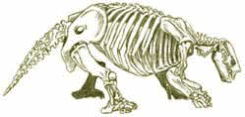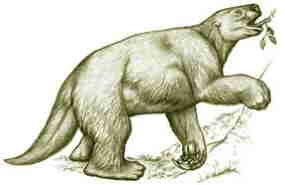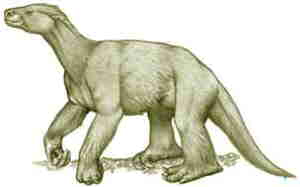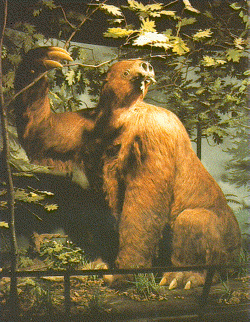 SKC Films Library SKC Films Library |
|
|
| SKC Films Library
>> Science >> Geology >> Paleontogy |
| Ground Sloths (Megatherium) large relatives of the modern two-toed and three-toed sloths Ground sloths evolved in South America around 35 million years ago, and migrated into North America, starting around 8 million years ago, with the last species arriving during the Pleistocene. All four species became extinct approximately 10,000 years ago. The reason for their extinction is not currently known. Description Ground sloths were roughly 20 feet long and weighed about 3 to 4 tons. The smallest species -- Shasta Ground Sloth -- was about 9 feet long and weighed up to 550 pounds (about the size of a modern black bear). They had very large claws, even though they were herbivores. The shape of their hip bones indicates that they could stand up on their hind legs, allowing them to reach high up into trees for the best leaves and twigs. It is likely that they walked on the sides of their hind feet and backs of their forefeet. skeleton of Harlan's Ground Sloth illustration showing the size of a
ground sloth relative to an adult human male Distribution and Habitat Fossil remains of the Shasta Ground Sloth have been found in Southern California (including the Rancho La Brea Tar Pits in Los Angeles) and Sonora, Mexico. The animal was especially adapted to life in arid regions. Jefferson's and Harlan's Ground Sloths are the only two species found in the Midwestern United States. Diet The flat grinding teeth of the Harlan's Ground Sloth suggest a diet of grasses, but they may have also fed on leaves, tree roots, and twigs. artist's rendering of a Harlan's
Ground Sloth Shasta Ground Sloth was most likely a browser. Fossilized dung shows that it fed on many species of plants such as yuccas, agaves, Joshua trees, globe mallows, mesquite and cacti. artist's rendering of a Shasta
Ground Sloth Jefferson's Ground Sloth probably specialized in eating leaves and twigs from trees of moist habitats (such as willows). reconstruction of a Jefferson's
Ground Sloth Fossil History The first report of a fossilized ground sloth in North America came from Thomas Jefferson. The fossils that were subsequently named for him were found in a cave in West Virginia in 1799. Numerous fossil remains of Harlan's Ground Sloths have been found at the Rancho La Brea Tar Pits in Los Angeles. Several complete ground sloth skeletons have been found within caves. Some of those skeletons have been found complete with hair, skin and tendons still attached. Fossilized dung has also been excavated from many caves, allowing scientists to gain information about the diet of these giant animals. Scientific Classification phylum Chordata
SEE ALSO |
SKC Films Library >> Science >> Geology >> Paleontology This page was last updated on 02/27/2017. |




